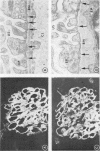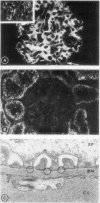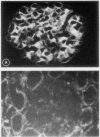Abstract
The development of immune deposits on the subepithelial surface of the glomerular capillary wall was studied in isolated rat kidneys perfused at controlled perfusion pressure, pH, temperature, and flow rates with recirculating oxygenated perfusate containing bovine serum albumin (BSA) in buffer and sheep antibody to rat proximal tubular epithelial cell brush border antigen (Fx1A). Control kidney were perfused with equal concentrations of non-antibody immunoglobulin (Ig)G. Renal function was monitored by measuring inulin clearance, sodium reabsorption, and urine flow as well as BSA excretion and fractional clearance. Perfused kidneys were studied by light, immunofluorescence, and electron microscopy. All kidneys perfused with anti-Fx1A developed diffuse, finely granular deposits of IgG along the glomerular capillary wall by immunofluorescence. Electron microscopy revealed these deposits to be localized exclusively in the subepithelial space and slit pores. Similar deposits were produced in a nonrecirculating perfusion system, thereby excluding the formation of immune complexes in the perfusate caused by renal release of tubular antigen. Control kidneys perfused with nonantibody IgG did not develop glomerular immune deposits. Renal function and BSA excretion were the same in experimental and control kidneys. Glomerular deposits in antibody perfused kidneys were indistinguishable from deposits in rats injected with anti-Fx1A or immunized with Fx1A to produce autologous immune complex nephropathy. These studies demonstrate that subepithelial immune deposits can be produced in the isolated rat kidney by perfusion with specific antibody to Fx1A in the absence of circulating immune complexes. In this model deposits result from in situ complex formation rather than circulating immune complex deposition.
Full text
PDF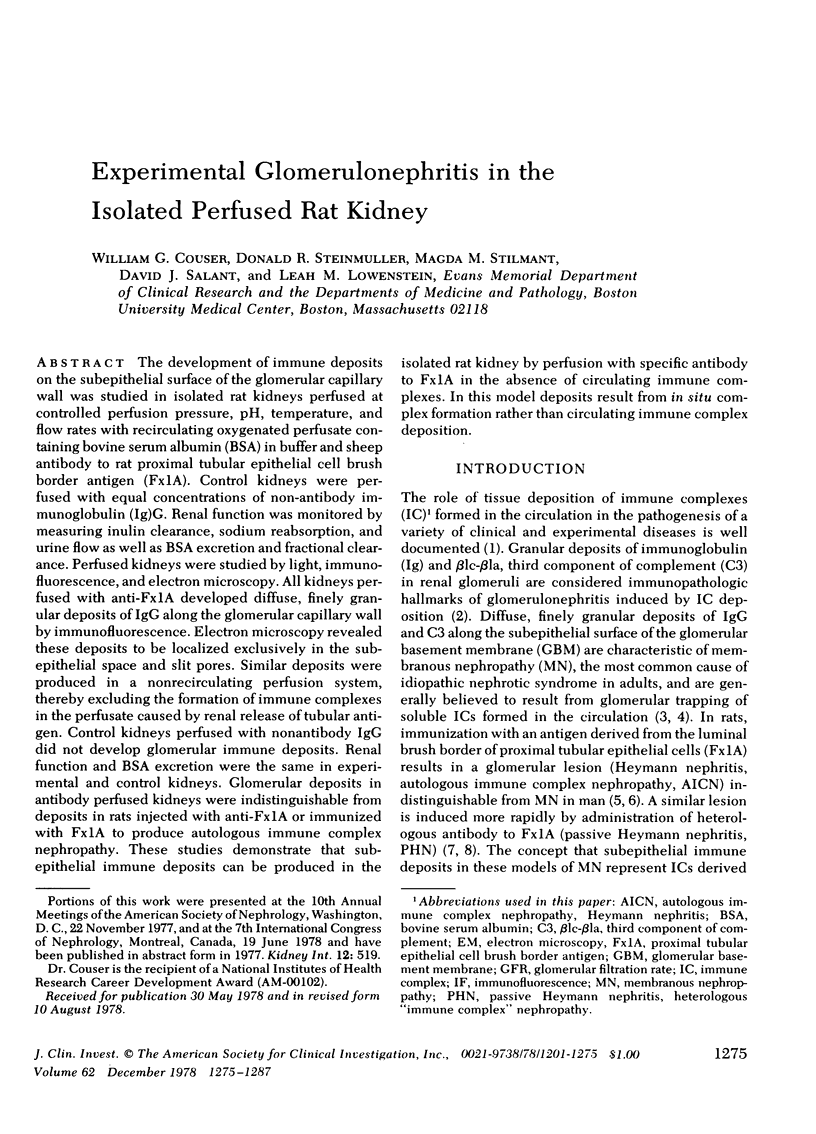
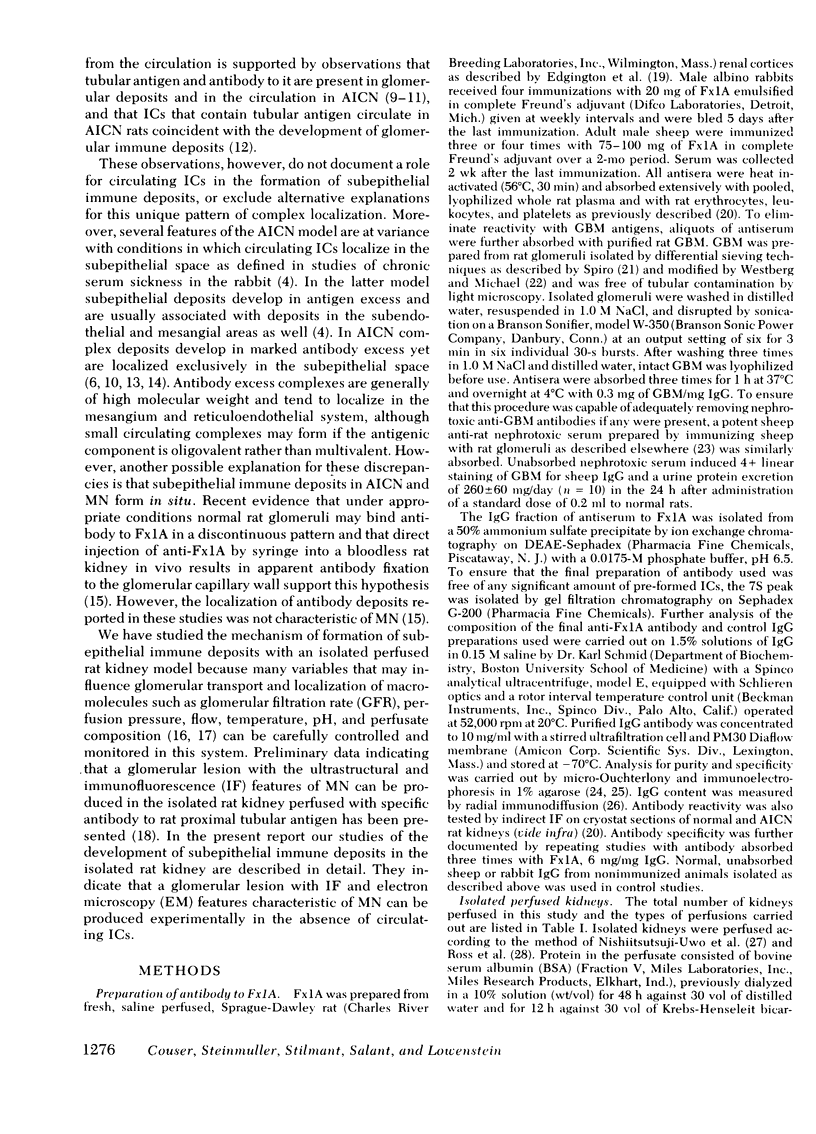
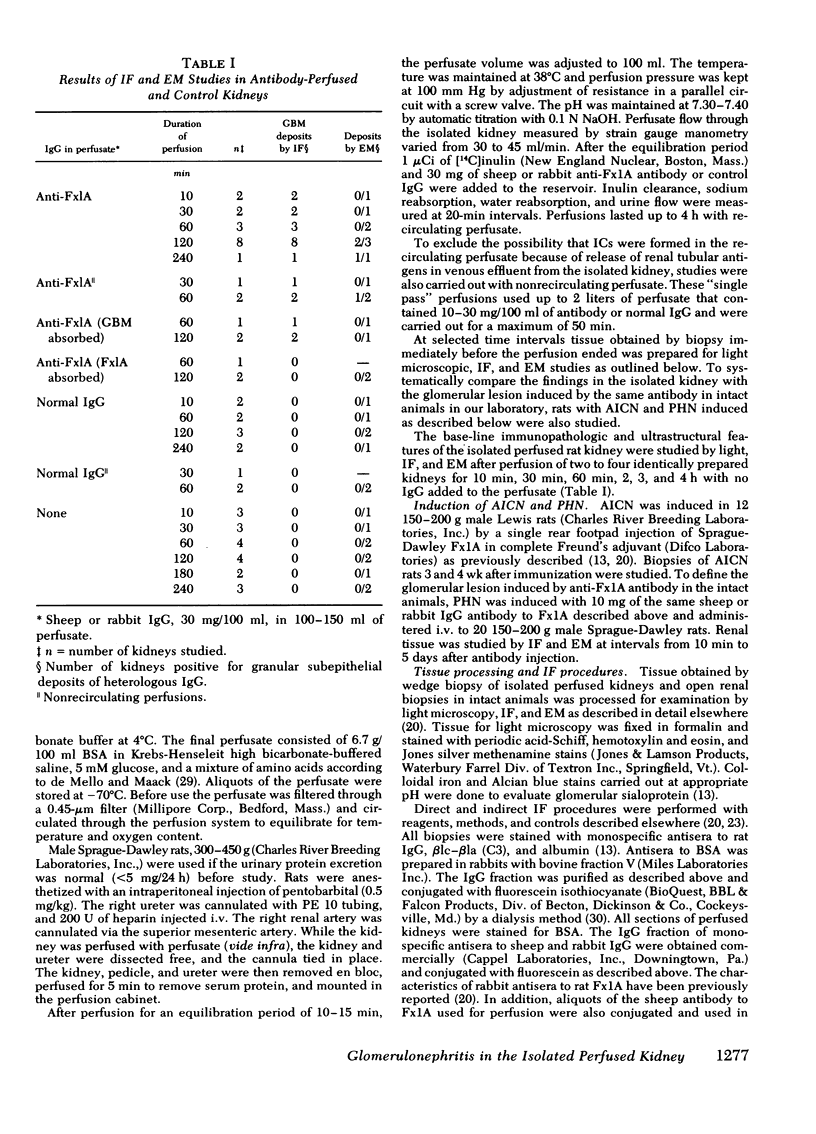
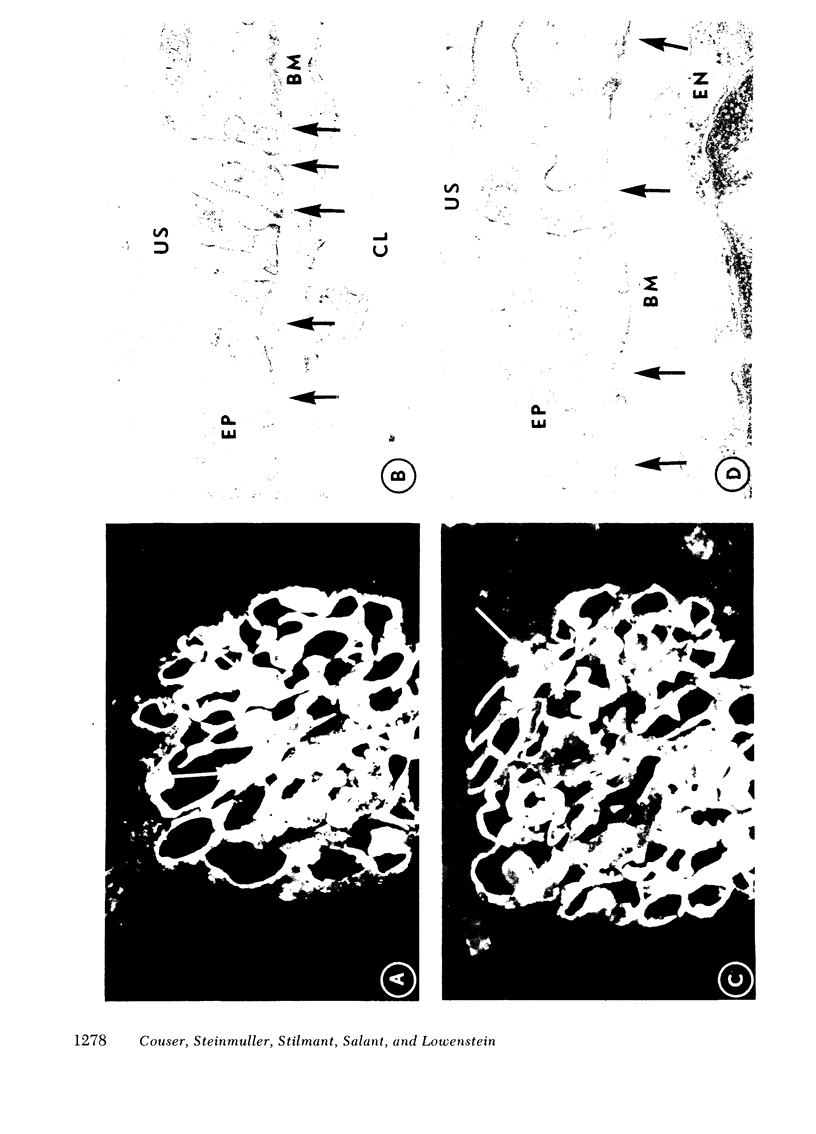
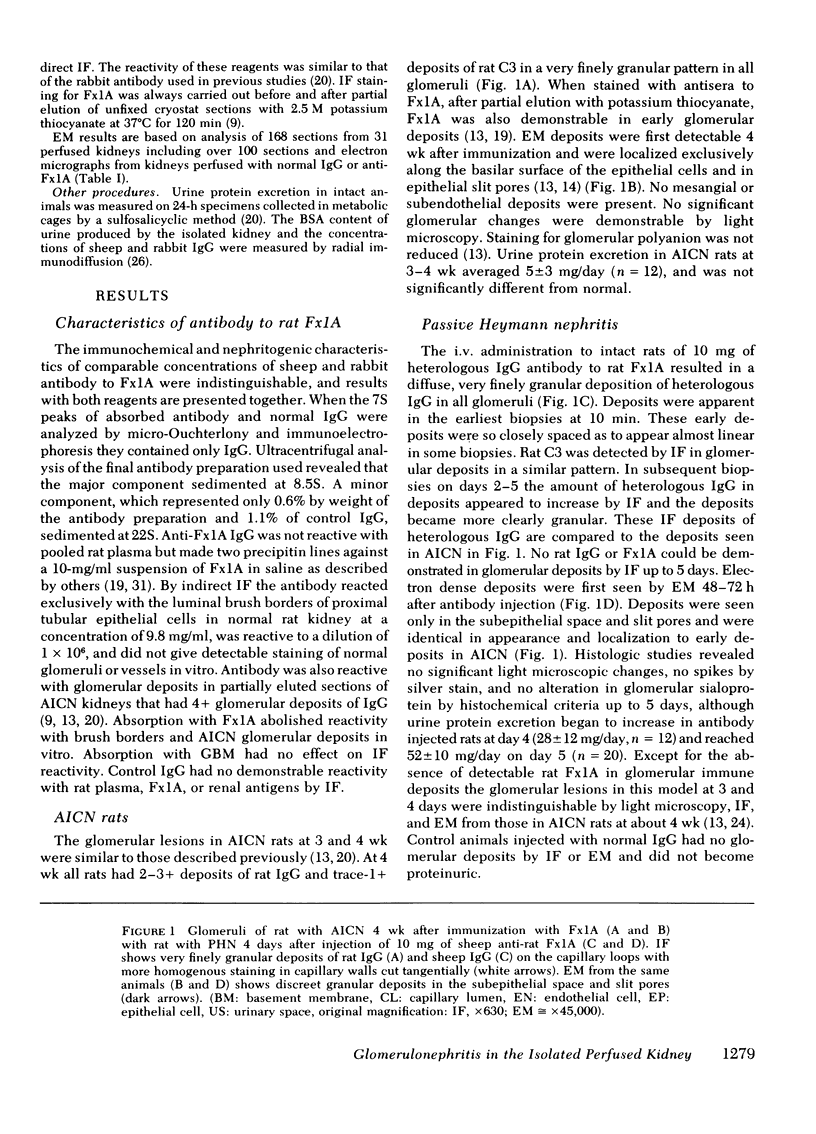
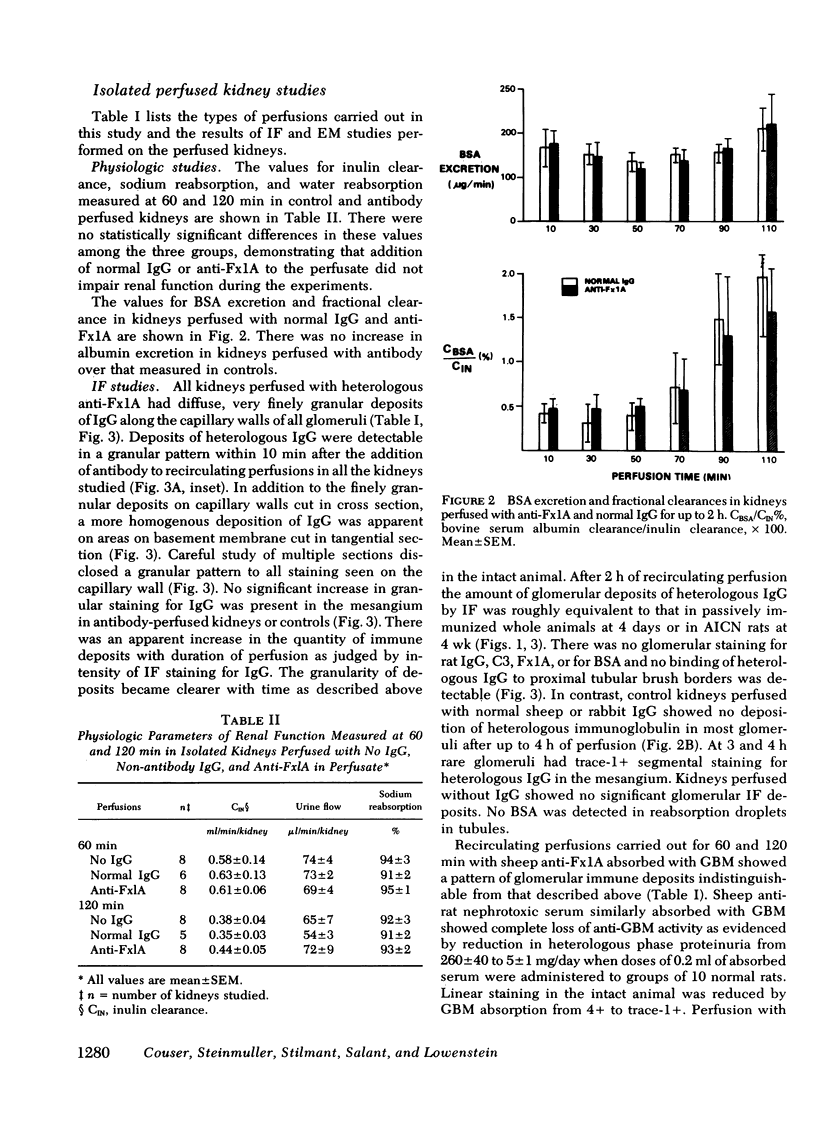
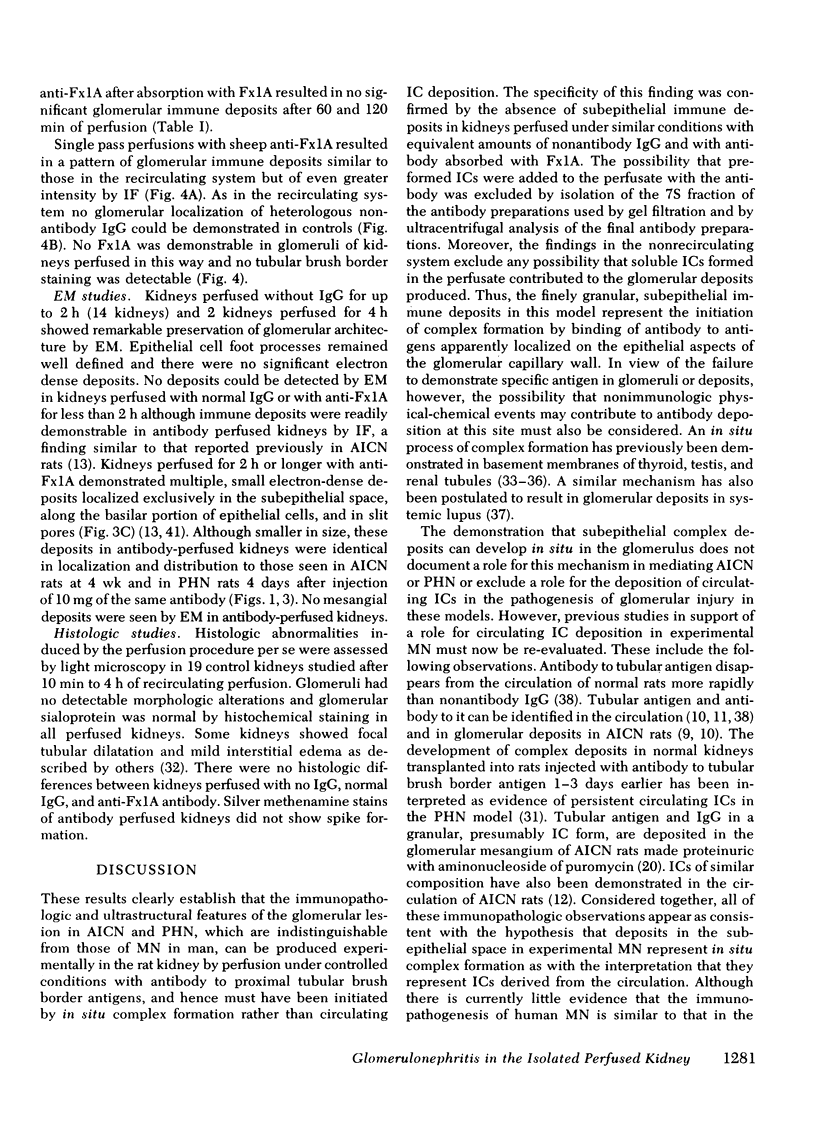
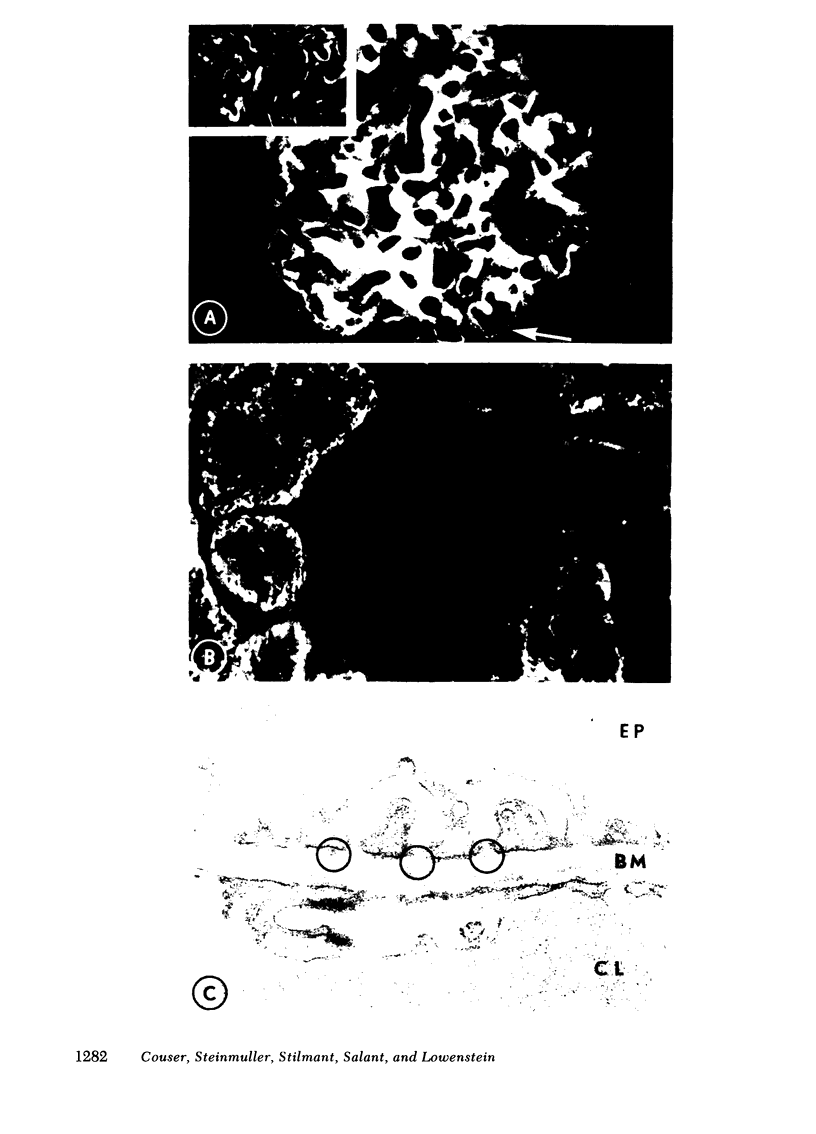
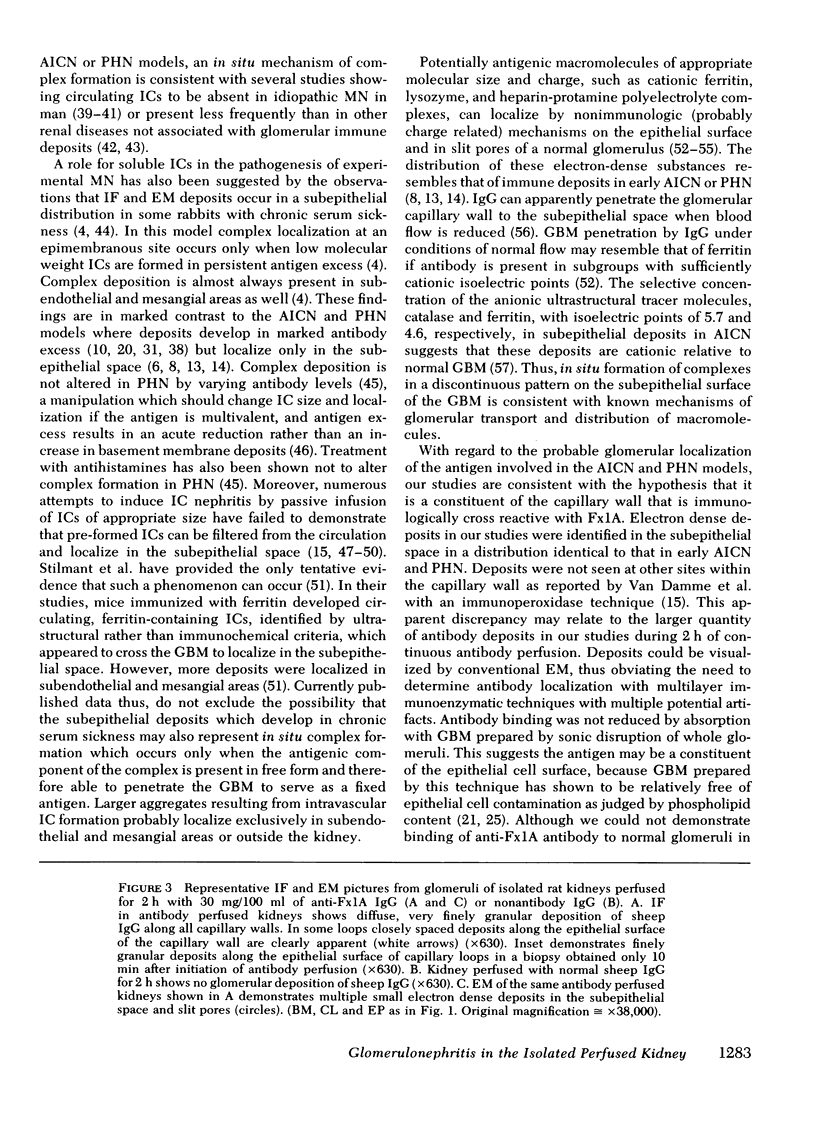
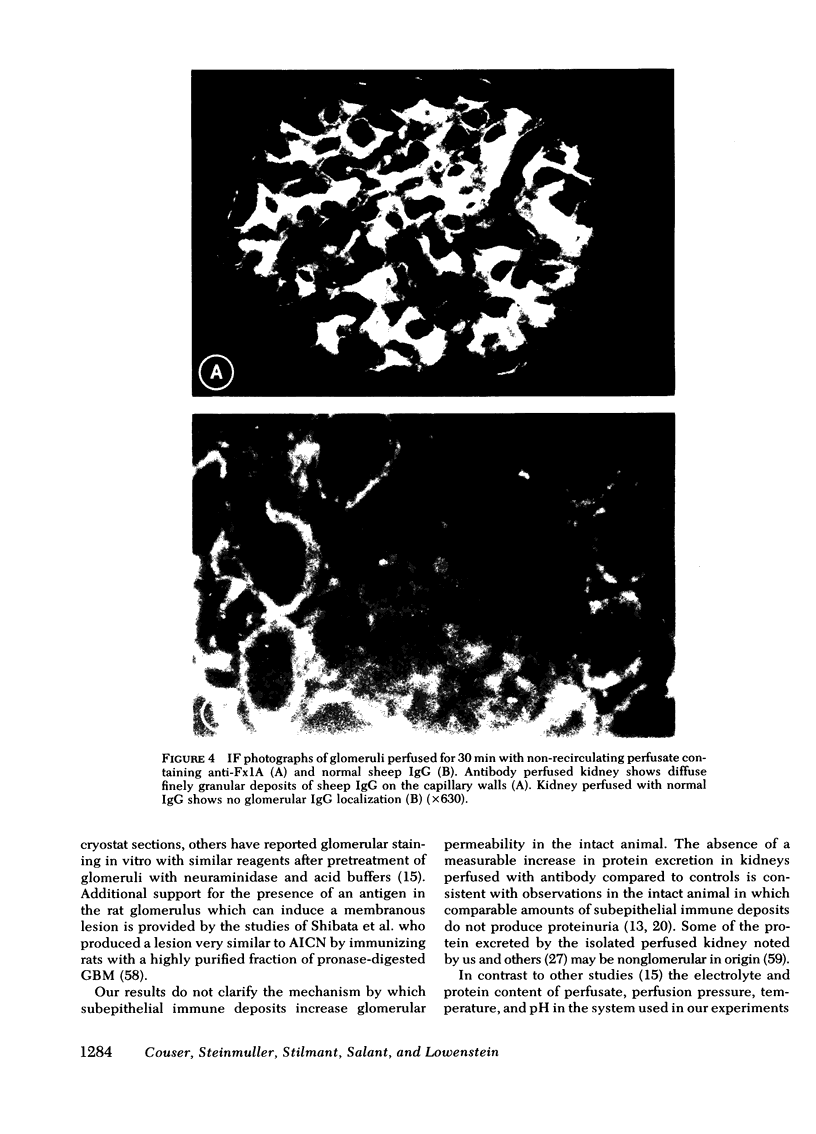
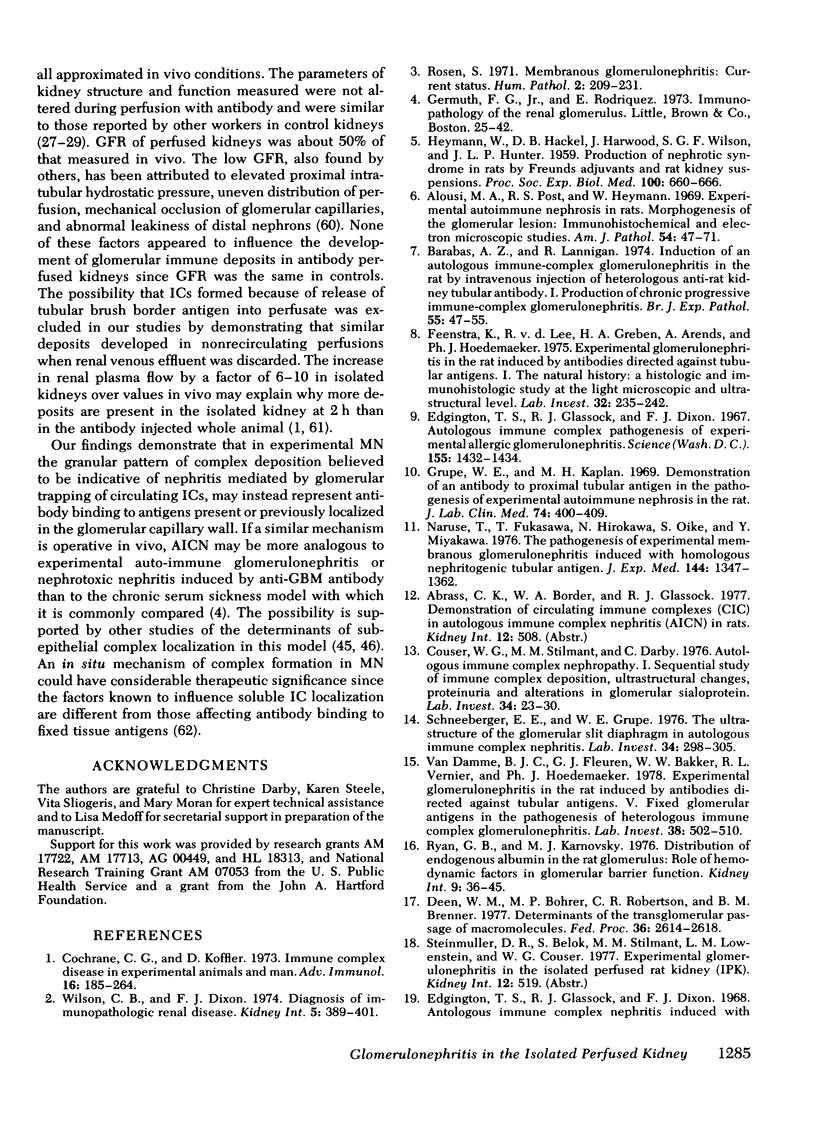
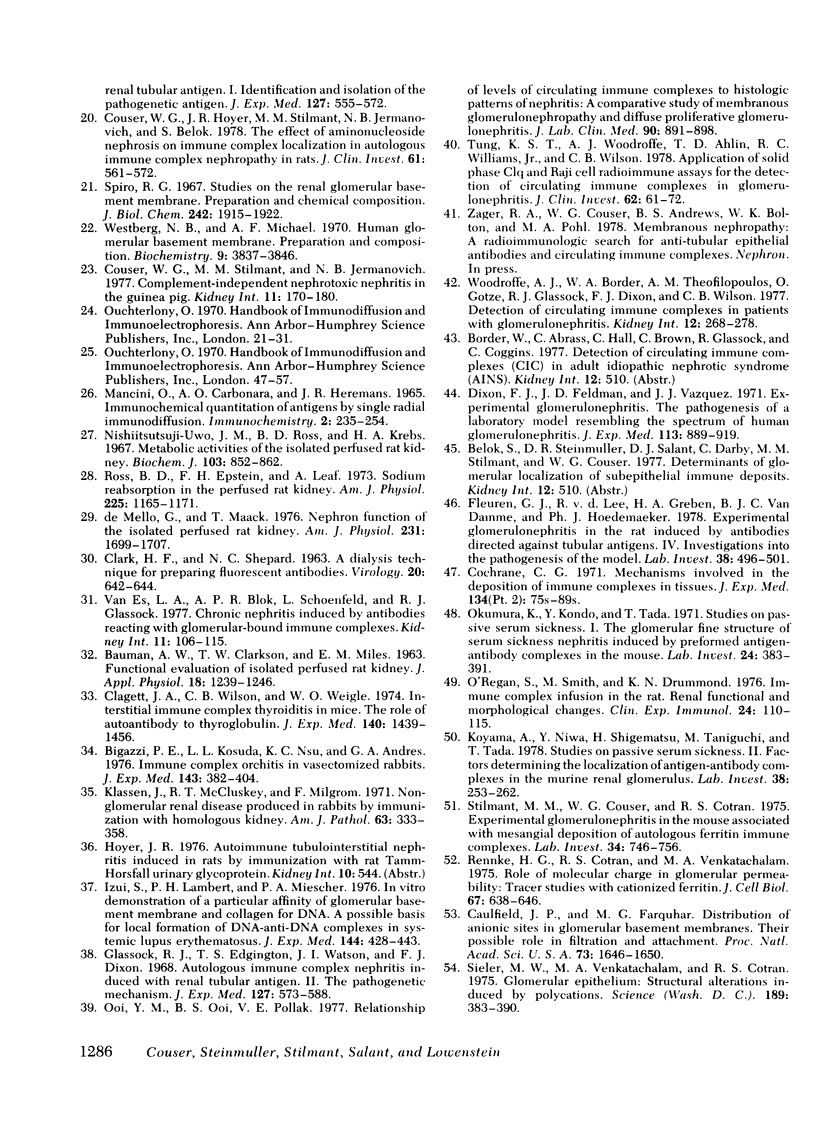
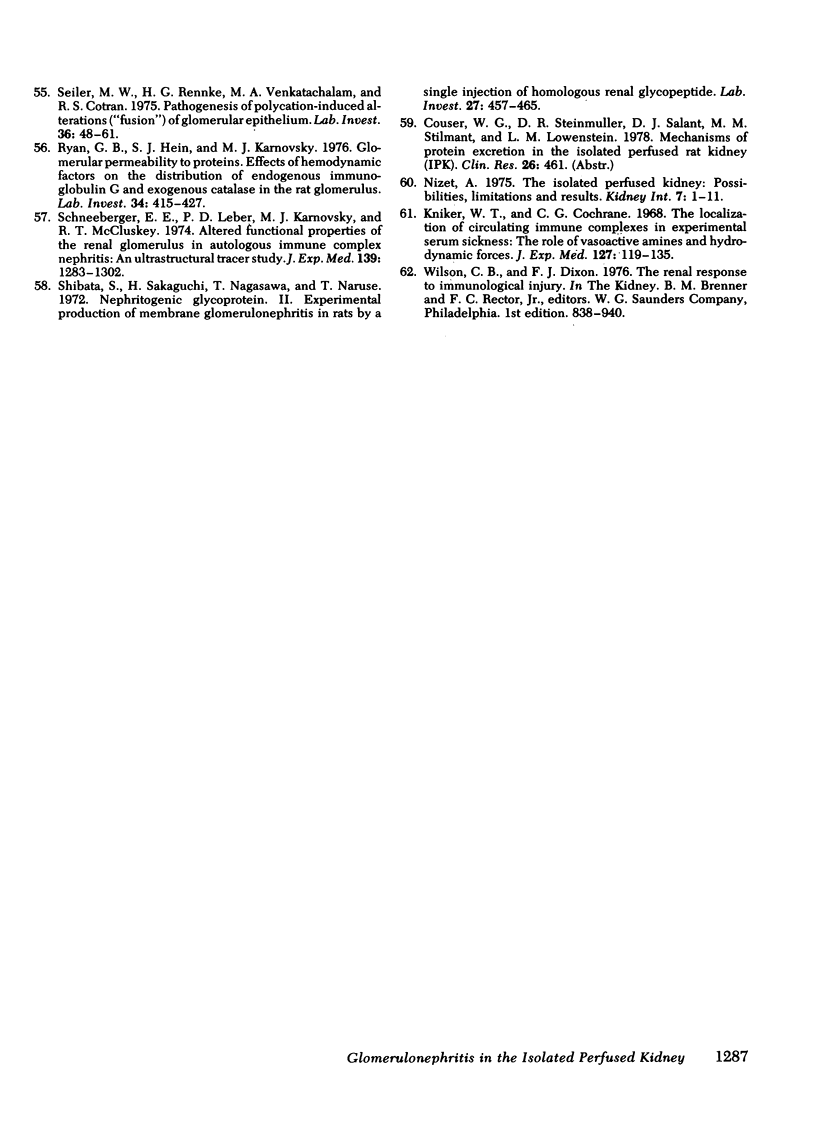
Images in this article
Selected References
These references are in PubMed. This may not be the complete list of references from this article.
- Alousi M. A., Post R. S., Heymann W. Experimental autoimmune nephrosis in rats. Morphogenesis of the glomerular lesion: immunohistochemical and electron microscopic studies. Am J Pathol. 1969 Jan;54(1):47–71. [PMC free article] [PubMed] [Google Scholar]
- BAUMAN A. W., CLARKSON T. W., MILES E. M. FUNCTIONAL EVALUATION OF ISOLATED PERFUSED RAT KIDNEY. J Appl Physiol. 1963 Nov;18:1239–1246. doi: 10.1152/jappl.1963.18.6.1239. [DOI] [PubMed] [Google Scholar]
- Barabas A. Z., Lannigan R. Induction of an autologous immune-complex glomerulonephritis in the rat by intravenous injection of heterologous anti-rat kidney tubular antibody. I. Production of chronic progressive immune-complex glomerulonephritis. Br J Exp Pathol. 1974 Feb;55(1):47–55. [PMC free article] [PubMed] [Google Scholar]
- Bigazzi P. E., Kosuda L. L., Hsu K. C., Andres G. A. Immune complex orchitis in vasectomized rabbits. J Exp Med. 1976 Feb 1;143(2):382–404. doi: 10.1084/jem.143.2.382. [DOI] [PMC free article] [PubMed] [Google Scholar]
- CLARK H. F., SHEPARD C. C. A DIALYSIS TECHNIQUE FOR PREPARING FLUORESCENT ANTIBODY. Virology. 1963 Aug;20:642–644. doi: 10.1016/0042-6822(63)90292-7. [DOI] [PubMed] [Google Scholar]
- Caulfield J. P., Farquhar M. G. Distribution of annionic sites in glomerular basement membranes: their possible role in filtration and attachment. Proc Natl Acad Sci U S A. 1976 May;73(5):1646–1650. doi: 10.1073/pnas.73.5.1646. [DOI] [PMC free article] [PubMed] [Google Scholar]
- Clagett J. A., Wilson C. B., Weigle W. O. Interstitial immune complex thyroiditis in mice: the role of autoantibody to thyroglobulin. J Exp Med. 1974 Dec 1;140(6):1439–1456. doi: 10.1084/jem.140.6.1439. [DOI] [PMC free article] [PubMed] [Google Scholar]
- Cochrane C. G., Koffler D. Immune complex disease in experimental animals and man. Adv Immunol. 1973;16(0):185–264. doi: 10.1016/s0065-2776(08)60298-9. [DOI] [PubMed] [Google Scholar]
- Cochrane C. G. Mechanisms involved in the deposition of immune complexes in tissues. J Exp Med. 1971 Sep 1;134(3 Pt 2):75s–89s. [PubMed] [Google Scholar]
- Couser W. G., Jermanovich N. B., Belok S., Stilmant M. M., Hoyer J. R. Effect of aminonucleoside nephrosis on immune complex localization in autologous immune complex nephropathy in rats. J Clin Invest. 1978 Mar;61(3):561–572. doi: 10.1172/JCI108967. [DOI] [PMC free article] [PubMed] [Google Scholar]
- Couser W. G., Stilmant M. M., Darby C. Autologous immune complex nephropathy. I. Sequential study of immune complex deposition, ultrastructural changes, proteinuria, and alterations in glomerular sialoprotein. Lab Invest. 1976 Jan;34(1):23–30. [PubMed] [Google Scholar]
- Couser W. G., Stilmant M. M., Jermanovich N. B. Complement-independent nephrotoxic nephritis in the guinea pig. Kidney Int. 1977 Mar;11(3):170–180. doi: 10.1038/ki.1977.25. [DOI] [PubMed] [Google Scholar]
- De Mello G., Maack T. Nephron function of the isolated perfused rat kidney. Am J Physiol. 1976 Dec;231(6):1699–1707. doi: 10.1152/ajplegacy.1976.231.6.1699. [DOI] [PubMed] [Google Scholar]
- Deen W. M., Bohrer M. P., Robertson C. R., Brenner B. M. Determinants of the transglomerular passage of macromolecules. Fed Proc. 1977 Nov;36(12):2614–2618. [PubMed] [Google Scholar]
- Edgington T. S., Glassock R. J., Dixon F. J. Autologous immune complex nephritis induced with renal tubular antigen. I. Identification and isolation of the pathogenetic antigen. J Exp Med. 1968 Mar 1;127(3):555–572. doi: 10.1084/jem.127.3.555. [DOI] [PMC free article] [PubMed] [Google Scholar]
- Edgington T. S., Glassock R. J., Dixon F. J. Autologous immune-complex pathogenesis of experimental allergic glomerulonephritis. Science. 1967 Mar 17;155(3768):1432–1434. doi: 10.1126/science.155.3768.1432. [DOI] [PubMed] [Google Scholar]
- Feenstra K., van den Lee R., Greben H. A., Arends A., Hoedemaeker P. J. Experimental glomerulonephritis in the rat induced by antibodies directed against tubular antigens. I. The natural history: a histologic and immunohistologic study at the light microscopic and the ultrastructural level. Lab Invest. 1975 Feb;32(2):235–242. [PubMed] [Google Scholar]
- Fleuren G. J., vd Lee R., Greben H. A., Van Damme B. J., Hoedemaeker P. J. Experimental glomerulonephritis in the rat induced by antibodies directed against tubular antigens. IV. Investigations into the pathogenesis of the model. Lab Invest. 1978 Apr;38(4):496–501. [PubMed] [Google Scholar]
- Glassock R. J., Edgington T. S., Watson J. I., Dixon F. J. Autologous immune complex nephritis induced with renal tubular antigen. II. The pathogenetic mechanism. J Exp Med. 1968 Mar 1;127(3):573–588. doi: 10.1084/jem.127.3.573. [DOI] [PMC free article] [PubMed] [Google Scholar]
- Grupe W. E., Kaplan M. H. Demonstration of an antibody to proximal tubular antigen in the pathogenesis of experimental autoimmune nephrosis in rats. J Lab Clin Med. 1969 Sep;74(3):400–409. [PubMed] [Google Scholar]
- HEYMANN W., HACKEL D. B., HARWOOD S., WILSON S. G., HUNTER J. L. Production of nephrotic syndrome in rats by Freund's adjuvants and rat kidney suspensions. Proc Soc Exp Biol Med. 1959 Apr;100(4):660–664. doi: 10.3181/00379727-100-24736. [DOI] [PubMed] [Google Scholar]
- Izui S., Lambert P. H., Miescher P. A. In vitro demonstration of a particular affinity of glomerular basement membrane and collagen for DNA. A possible basis for a local formation of DNA-anti-DNA complexes in systemic lupus erythematosus. J Exp Med. 1976 Aug 1;144(2):428–443. doi: 10.1084/jem.144.2.428. [DOI] [PMC free article] [PubMed] [Google Scholar]
- Klassen J., McCluskey R. T., Milgrom F. Nonglomerular renal disease produced in rabbits by immunization with homologous kidney. Am J Pathol. 1971 May;63(2):333–358. [PMC free article] [PubMed] [Google Scholar]
- Kniker W. T., Cochrane C. G. The localization of circulating immune complexes in experimental serum sickness. The role of vasoactive amines and hydrodynamic forces. J Exp Med. 1968 Jan 1;127(1):119–136. doi: 10.1084/jem.127.1.119. [DOI] [PMC free article] [PubMed] [Google Scholar]
- Koyama A., Niwa Y., Shigematsu H., Taniguchi M., Tada T. Studies on passive serum sickness. II. Factors determining the localization of antigen-antibody complexes in the murine renal glomerulus. Lab Invest. 1978 Mar;38(3):253–262. [PubMed] [Google Scholar]
- Mancini G., Carbonara A. O., Heremans J. F. Immunochemical quantitation of antigens by single radial immunodiffusion. Immunochemistry. 1965 Sep;2(3):235–254. doi: 10.1016/0019-2791(65)90004-2. [DOI] [PubMed] [Google Scholar]
- Naruse T., Fukasawa T., Hirokawa N., Oike S., Miyakawa Y. The pathogenesis of experimental membranous glomerulonephritis induced with homologous nephritogenic tubular antigen. J Exp Med. 1976 Nov 2;144(5):1347–1362. doi: 10.1084/jem.144.5.1347. [DOI] [PMC free article] [PubMed] [Google Scholar]
- Nishiitsutsuji-Uwo J. M., Ross B. D., Krebs H. A. Metabolic activities of the isolated perfused rat kidney. Biochem J. 1967 Jun;103(3):852–862. doi: 10.1042/bj1030852. [DOI] [PMC free article] [PubMed] [Google Scholar]
- Nizet A. The isolated perfused kidney: possibilities, limitations and results. Kidney Int. 1975 Jan;7(1):1–11. doi: 10.1038/ki.1975.1. [DOI] [PubMed] [Google Scholar]
- O'Regan S., Smith M., Drummond K. N. Immune complex infusion in the rat. Renal functional and morphological changes. Clin Exp Immunol. 1976 Apr;24(1):110–115. [PMC free article] [PubMed] [Google Scholar]
- Okumura K., Kondo Y., Tada T. Studies on passive serum sickness. I. The glomerular fine structure of serum sickness nephritis induced by preformed antigen-antibody complexes in the mouse. Lab Invest. 1971 May;24(5):383–391. [PubMed] [Google Scholar]
- Ooi Y. M., Ooi B. S., Pollak V. E. Relationship of levels of circulating immune complexes to histologic patterns of nephritis: a comparative study of membranous glomerulonephropathy and diffuse proliferative glomerulonephritis. J Lab Clin Med. 1977 Nov;90(5):891–898. [PubMed] [Google Scholar]
- Rennke H. G., Cotran R. S., Venkatachalam M. A. Role of molecular charge in glomerular permeability. Tracer studies with cationized ferritins. J Cell Biol. 1975 Dec;67(3):638–646. doi: 10.1083/jcb.67.3.638. [DOI] [PMC free article] [PubMed] [Google Scholar]
- Rosen S. Membranous glomerulonephritis: current status. Hum Pathol. 1971 Jun;2(2):209–231. doi: 10.1016/s0046-8177(71)80035-7. [DOI] [PubMed] [Google Scholar]
- Ross B. D., Epstein F. H., Leaf A. Sodium reabsorption in the perfused rat kidney. Am J Physiol. 1973 Nov;225(5):1165–1171. doi: 10.1152/ajplegacy.1973.225.5.1165. [DOI] [PubMed] [Google Scholar]
- Ryan G. B., Hein S. J., Karnovsky M. J. Glomerular permeability to proteins. Effects of hemodynamic factors on the distribution of endogenous immunoglobulin G and exogenous catalase in the rat glomerulus. Lab Invest. 1976 Apr;34(4):415–427. [PubMed] [Google Scholar]
- Ryan G. B., Karnovsky M. J. Distribution of endogenous albumin in the rat glomerulus: role of hemodynamic factors in glomerular barrier function. Kidney Int. 1976 Jan;9(1):36–45. doi: 10.1038/ki.1976.5. [DOI] [PubMed] [Google Scholar]
- Schneeberger E. E., Grupe W. E. The ultrastructure of the glomerular slit diaphragm in autologous immune complex nephritis. Lab Invest. 1976 Mar;34(3):298–305. [PubMed] [Google Scholar]
- Schneeberger E. E., Leber P. D., Karnovsky M. J., McCluskey R. T. Altered functional properties of the renal glomerulus in autologous immune complex nephritis: an ultrastructural tracer study. J Exp Med. 1974 May 1;139(5):1283–1302. doi: 10.1084/jem.139.5.1283. [DOI] [PMC free article] [PubMed] [Google Scholar]
- Seiler M. W., Rennke H. G., Venkatachalam M. A., Cotran R. S. Pathogenesis of polycation-induced alterations ("fusion") of glomerular epithelium. Lab Invest. 1977 Jan;36(1):48–61. [PubMed] [Google Scholar]
- Shibata S., Sakaguchi H., Nagasawa T., Naruse T. Nephritogenic glycoprotein. II. Experimental production of membranous glomerulonephritis in rats by a single injection of homologous renal glycopeptide. Lab Invest. 1972 Nov;27(5):457–465. [PubMed] [Google Scholar]
- Spiro R. G. Studies on the renal glomerular basement membrane. Preparation and chemical composition. J Biol Chem. 1967 Apr 25;242(8):1915–1922. [PubMed] [Google Scholar]
- Stilmant M. M., Couser W. G., Cotran R. S. Experimental glomerulonephritis in the mouse associated with mesangial deposition ofautologous ferritin immune complexes. Lab Invest. 1975 Jun;32(6):746–756. [PubMed] [Google Scholar]
- Tung K. S., Woodroffe A. J., Ahlin T. D., Williams R. C., Jr, Wilson C. B. Application of the solid phase C1q and Raji cell radioimmune assays for the detection of circulating immune complexes in glomerulonephritis. J Clin Invest. 1978 Jul;62(1):61–72. doi: 10.1172/JCI109115. [DOI] [PMC free article] [PubMed] [Google Scholar]
- Van Damme B. J., Fleuren G. J., Bakker W. W., Vernier R. L., Hoedemaeker P. J. Experimental glomerulonephritis in the rat induced by antibodies directed against tubular antigens. V. Fixed glomerular antigens in the pathogenesis of heterologous immune complex glomerulonephritis. Lab Invest. 1978 Apr;38(4):502–510. [PubMed] [Google Scholar]
- Westberg N. G., Michael A. F. Human glomerular basement membrane. Preparation and composition. Biochemistry. 1970 Sep 15;9(19):3837–3846. doi: 10.1021/bi00821a025. [DOI] [PubMed] [Google Scholar]
- Wilson C. B., Dixon F. J. Diagnosis of immunopathologic renal disease. Kidney Int. 1974 Jun;5(6):389–401. doi: 10.1038/ki.1974.57. [DOI] [PubMed] [Google Scholar]
- Woodroffe A. J., Border W. A., Theofilopoulos A. N., Götze O., Glassock R. J., Dixon F. J., Wilson C. B. Detection of circulating immune complexes in patients with glomerulonephritis. Kidney Int. 1977 Oct;12(4):268–278. doi: 10.1038/ki.1977.111. [DOI] [PubMed] [Google Scholar]
- van Es L. A., Blok A. P., Schoenfield L., Glassock R. J. Chronic nephritis induced by antibodies reacting with glomerular-bound immune complexes. Kidney Int. 1977 Feb;11(2):106–115. doi: 10.1038/ki.1977.15. [DOI] [PubMed] [Google Scholar]



